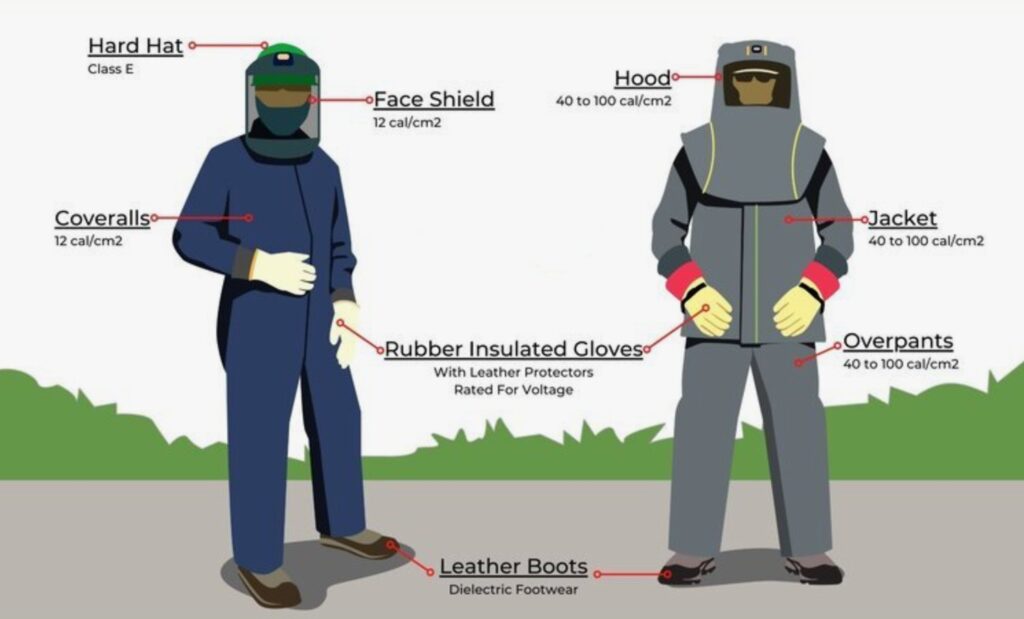Arc protection PPE (Personal Protective Equipment) is designed to protect workers from the thermal hazards of an arc flash. An arc flash is a dangerous release of energy caused by an electrical fault. Here’s an overview of arc protection PPE and instructions for use:

Types of Arc Protection PPE
- Arc-Rated Clothing:
- Shirts and Pants: Made of flame-resistant fabrics with arc ratings. These should cover the entire body.
- Coveralls: Full-body suits that provide additional protection.
- Jackets: For additional layering and protection in colder environments.
- Arc Flash Face Shields and Hoods:
- Face Shields: Provide protection for the face and neck. Should be used with an appropriate helmet.
- Hoods: Offer full head and neck protection, typically used with a face shield for enhanced safety.
- Gloves:
- Arc-Rated Gloves: Protect hands from thermal burns. Should also provide electrical insulation.
- Safety Glasses:
- Arc-Rated Safety Glasses: Protect the eyes from intense light and potential flying debris during an arc flash.
- Hearing Protection:
- Ear Plugs or Muffs: Protect hearing from the loud noise generated by an arc flash.
- Boots:
- Arc-Rated Boots: Made of materials that won’t ignite or melt when exposed to an arc flash.
Select PPE Based on Arc Rating
Hard Hats: Use Type 1 or 2 (ANSI Z89.1) with arc-rated accessories.
Arc-Rated (AR) Clothing:
Material: Choose fabrics tested under ASTM F1959 (e.g., flame-resistant (FR) cotton blends or engineered synthetics) with an Arc Thermal Performance Value (ATPV) or Energy Breakopen Threshold (EBT) matching the calculated incident energy.
Layering: Multi-layer systems (e.g., shirt + jacket) may enhance protection but must be tested as a composite.
Face and Head Protection:
Face Shields: Must meet ASTM F2178 (minimum 8 cal/cm²) and pair with arc-rated balaclavas.
Verify Compliance with Standards
| PPE Type | Key Standards | Requirements |
|---|---|---|
| Clothing | ASTM F1506, NFPA 2112 | ATPV/EBT labeling, flame resistance 13 |
| Gloves | ASTM F2675 | Arc-rated with cut resistance 6 |
| Face Shields | ASTM F2178 | Minimum 8 cal/cm² rating |
Instructions for Use
- Pre-Use Inspection:
- Inspect all PPE for any signs of damage or wear. Do not use damaged PPE.
- Donning (Putting On) PPE:
- Follow the manufacturer’s instructions for donning PPE. Ensure all clothing is fastened securely.
- Wear a base layer of arc-rated clothing if required.
- Ensure all parts of the body are covered, including the neck, wrists, and ankles.
- While Working:
- Follow safe work practices as outlined in NFPA 70E or your organization’s safety protocols.
- Maintain a safe distance from potential arc flash sources.
- Use insulated tools and equipment rated for the voltage levels you will be working with.
- Doffing (Taking Off) PPE:
- Remove PPE carefully to avoid contamination.
- Follow proper procedures for cleaning and storing PPE.
- Maintenance and Care:
- Regularly clean and inspect PPE according to the manufacturer’s instructions.
- Store PPE in a clean, dry place away from direct sunlight and chemicals.
Additional Resources
- Training: Ensure all workers receive proper training on the use and maintenance of arc protection PPE.
- Risk Assessment: Conduct regular risk assessments to determine the appropriate level of PPE needed for specific tasks.
- Emergency Procedures: Have clear procedures in place for dealing with arc flash incidents, including first aid and medical response.

